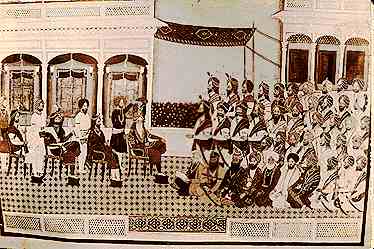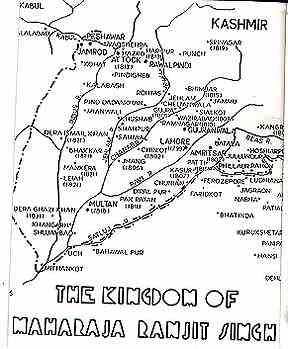Sher-e-Punjab
Maharaja Ranjit Singh-Page3


Much has been written about the questionable manner in which Ranjit Singh exacted the Koh-i-noor from the deposed Shah Shuja in I 813 The arguments both for and against Ranjit Singh's behaviour have been stated in Singh (1962), I05-I09. Its history up to the date of its acquisition by the British was recorded by Fakir Nuruddin at the request of Major C. Macgregor, Deputy Commissioner, Lahore. The information was contained in a letter dated 10 February 1850. The letter itself is in the Punjab University Library.
Less has been written about its subsequent history. It was set by Ranjit Siugh as the centre-piece to an amulet, flanked by two lesser diamonds which, according to Hugel (1845), 303, the Maharaja had purchased for 130,000 and 100,000 rupees in Amritsar. They had belonged to Shah Shuja also and would seem to have been acquired by Ranjit Singh, if Hugel is to be believed, with less effort than he spent on the Koh-i-noor.
Burnes (1834), III, 168, judged it to be 'about half the size of an egg'; Osborne (1840), 202, gave more exact measurements 'about an inch and a halfin length, and upwards of an inch in width, and stands out from the setting, about half an inch'; Emily Eden (1844), sketched it and reproduced the drawing.
Custody of the stone was taken in 1849 by Dr Login from Misr Makraj, younger brother of Misr Beli Ram and an employee of the royal toshakhana for over thirty two years, who passed to his successor the advice that when showing the Koh-i-noor to visitors it was advisable to hold it in one's own hand and to keep the cords twisted about one's fingers as an additional precaution. Obviously, Shah Shuja had been no pupil of Misr Makraj's.
The stone was dispatched to England despite Sir John Lawrence 5 momentary carelessness in forgetting it in his waistcoat pocket. It arrived there in 1850 and was shown at the Great Exhibition a year later. The stone was re-cut on the orders of Queen Victoria, to whom it had been presented by the East India Company, and reduced from its original size of 86 to 106 carats. It was used by her sometimes separately as a brooch or set in a circlet specially designed for it.
After her death in 1901, the Koh'i-noor was used in the coronation crowns of Queen Alexandra, consort of Edward VII, in 1902; Queen Mary, consort of George V, in 1911; and of Queen Elizabeth, consort of George VI, in 1937. The Kohinoor is still in the latter crown, which is displayed among the Crown Jewels in the Tower of London. The original amulet containing paste facsimiles is also on display in a side showcase. The amulet and its enameled reverse have been reproduced in Twining (1960), pls. 70 a and b.
The diamonds formerly flanking the Koh-i-noor are now mounted for use as earrings.
Most Paintings in this section has been taken with courtesy of A. Aijazuddin, and World Heritage Museum.